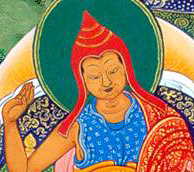Kamalaśīla: Difference between revisions
No edit summary |
No edit summary |
||
| Line 14: | Line 14: | ||
|StudentOf=Śāntarakṣita | |StudentOf=Śāntarakṣita | ||
|BdrcLink=https://www.tbrc.org/#!rid=P7641 | |BdrcLink=https://www.tbrc.org/#!rid=P7641 | ||
|BnwShortPersonBio=One of the most important Madhyamaka authors of late Indian Buddhism, a major representative of the Yogācāra-Madhyamaka synthesis, and a participant in the famous Bsam yas Debate. According to Tibetan doxographies, he was a proponent of the Yogācāra-Svātantrika-Madhyamaka. Although little is known about his life, according to Tibetan sources he was a monk and teacher at Nālandā. Tibetan sources also count him as one of three (together with Śāntarakṣita and Jñãnagarbha) “Eastern Svātantrikas” (rang rgyud shar gsum), suggesting that he was from Bengal. He was clearly a direct disciple of Śāntarakṣita, composing important commentaries on his teacher’s two major works, the ''Madhyamakālaṃkāra'' and the ''Tattvasaṃgraha''. | |||
The latter commentary, which is extant in Sanskrit, is an important source for both Hindu and Buddhist philosophical positions in the eighth century. (Source: "Kamalaśīla." In ''The Princeton Dictionary of Buddhism'', 411. Princeton University Press, 2014. http://www.jstor.org/stable/j.ctt46n41q.27.) | |||
|PosBuNayDefProv=Provisional | |PosBuNayDefProv=Provisional | ||
|PosBuNayDefProvNotes="In another context, Kamalasila quotes the passage from the Latikâvatârasütra cited by Candraklrti as scriptural authority for Buddha-nature being of provisional meaning. Kamalasila himself, though, does not put it quite that way, stating only that, in accord with the various outlooks of sentient beings, the Buddhas taught what is a single dharmadhâtu (or dharmanairâtmya in the Lankâvatârasütra) by means of many different expressions (including the expression “Buddha-nature”), that is, in conventional terms." [[Kano. K.]], [[Buddha-Nature and Emptiness]], p.11. | |PosBuNayDefProvNotes="In another context, Kamalasila quotes the passage from the Latikâvatârasütra cited by Candraklrti as scriptural authority for Buddha-nature being of provisional meaning. Kamalasila himself, though, does not put it quite that way, stating only that, in accord with the various outlooks of sentient beings, the Buddhas taught what is a single dharmadhâtu (or dharmanairâtmya in the Lankâvatârasütra) by means of many different expressions (including the expression “Buddha-nature”), that is, in conventional terms." [[Kano. K.]], [[Buddha-Nature and Emptiness]], p.11. | ||
Revision as of 11:48, 24 October 2019
| PersonType | Category:Classical Indian Authors |
|---|---|
| MainNameTib | པདྨའི་ངང་ཚུལ་ |
| MainNameWylie | pad+ma'i ngang tshul |
| MainNameSkt | Kamalaśīla |
| YearBirth | 713/740 |
| YearDeath | 763/795 |
| ReligiousAffiliation | Nalanda |
| StudentOf | Śāntarakṣita |
| BDRC | https://www.tbrc.org/#!rid=P7641 |
| IsInGyatsa | No |
| BnwShortPersonBio | One of the most important Madhyamaka authors of late Indian Buddhism, a major representative of the Yogācāra-Madhyamaka synthesis, and a participant in the famous Bsam yas Debate. According to Tibetan doxographies, he was a proponent of the Yogācāra-Svātantrika-Madhyamaka. Although little is known about his life, according to Tibetan sources he was a monk and teacher at Nālandā. Tibetan sources also count him as one of three (together with Śāntarakṣita and Jñãnagarbha) “Eastern Svātantrikas” (rang rgyud shar gsum), suggesting that he was from Bengal. He was clearly a direct disciple of Śāntarakṣita, composing important commentaries on his teacher’s two major works, the Madhyamakālaṃkāra and the Tattvasaṃgraha.
The latter commentary, which is extant in Sanskrit, is an important source for both Hindu and Buddhist philosophical positions in the eighth century. (Source: "Kamalaśīla." In The Princeton Dictionary of Buddhism, 411. Princeton University Press, 2014. http://www.jstor.org/stable/j.ctt46n41q.27.) |
| PosBuNayDefProv | Provisional |
| PosBuNayDefProvNotes | "In another context, Kamalasila quotes the passage from the Latikâvatârasütra cited by Candraklrti as scriptural authority for Buddha-nature being of provisional meaning. Kamalasila himself, though, does not put it quite that way, stating only that, in accord with the various outlooks of sentient beings, the Buddhas taught what is a single dharmadhâtu (or dharmanairâtmya in the Lankâvatârasütra) by means of many different expressions (including the expression “Buddha-nature”), that is, in conventional terms." Kano. K., Buddha-Nature and Emptiness, p.11. |
| PosAllBuddha | Qualified Yes |
| PosAllBuddhaNote | In the sense that all beings have the potential to achieve Buddhahood. |
| PosAllBuddhaMoreNotes | "The teaching “all sentient beings have Buddha-nature” is
interpreted in the sense that all sentient beings are pervaded by the dharmadhätu, which is characterized by selflessness. In other words, the tathägatagarbha is taken to be the dharmadhätugarbha. Though the term dharmadhätugarbha appears in the RGVV, Kamalasila's interpretation seems to have been derived from a phrase in the Lankävatärasütra, “the embryo of the tathägata, which is selflessness” (tathägatanairätmyagarbha),reinforcing the notion that Buddha-nature does not refer to ätman but rather to selflessness (nairātmya)." Kano. K., Buddha-Nature and Emptiness, p. 10. |
| PosYogaMadhya | Madhyamaka |
| PosVehicles | 1 |
| PosVehiclesNotes | "In his Madhyamakäloka, Kamalasila presents the position of an opponent who takes the three-vehicle theory to be definitive. He refutes that position and makes the case for the single-vehicle theory being definitive by quoting a number of sutra passages." Kano. K., Buddha-Nature and Emptiness, p. 9. |
| PosEmptyLuminNotes | Karl includes him in the first category (emptiness), but he seems to fall somewhere between that and the second (luminous nature), which he defines as selflessness (nairātmya).
|
| Other wikis |
If the page does not yet exist on the remote wiki, you can paste the tag |

